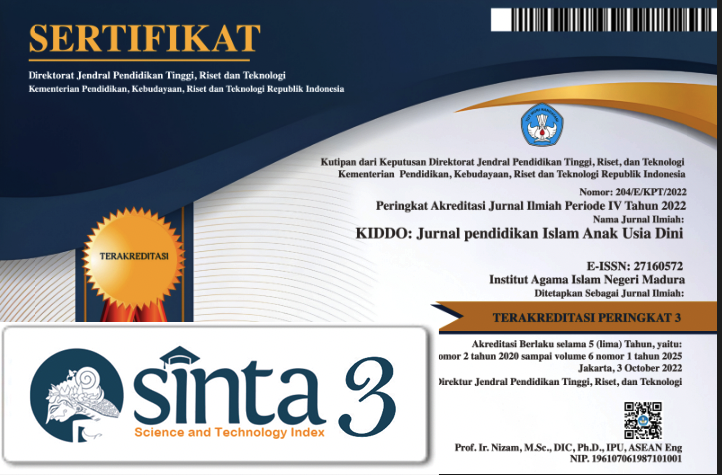Is Bullying a Moral Disability? Identification of Bullying Behavior In Kindergarten
 Abstract views: 149
,
Abstract views: 149
,
 PDF downloads: 122
PDF downloads: 122
Abstract
The phenomenon of bullying is a crucial issue that invoked children’s daily lives in school environment. Bullying does not only occured at primary and secondary school levels, but generally its existence can be identified since children on the early educational stage. Understanding bullying behavior and actions carried out by children, both as actors and victims, required serious treatment. Children are in the early cognitive development phase and have a moral dilemma, which causes bullying to become a nature. This research is a qualitative study with a phenomenological approach to explore narratives of bullying behavior on early childhood in kindergarten schools spread across the Kalimantan region. Through obtaining informant data from teachers at schools, it was found that bullying usually happen in physical, verbal and relational forms. Gender differences between boys and girls also influence the tendency for forms of bullying. Teachers' mechanism efforts to overcome bullying are brought in many strategies that focus on both the perpetrator, target and mediator.
Downloads
References
Agustin Ningrum, M., & Mahendra R. K. Wardhani, A. (2021). Pengembangan Buku Panduan Anti-Bullying untuk Mengembangkan Keterampilan Sosial-Emosional Anak Usia Dini. Golden Age: Jurnal Ilmiah Tumbuh Kembang Anak Usia Dini, 6(3), 131–142.
Alsaker, F. (2008). Bullying in kindergarten and prevention.
Ambarini, R., Indrariani, E. A., & Zahraini, A. D. (2018). Antisipasi Pencegahan Bullying Sedini Mungkin: Program Anti Bullying Terintegrasi untuk Anak Usia Dini. JDC, 2(2).
Camodeca, M., & Goossens, F. A. (2005b). Children’s opinions on effective strategies to cope with bullying: The importance of bullying role and perspective. Educational Research, 47(1), 93–105.
Connell, N. M., Morris, R. G., & Piquero, A. R. (2016). Predicting bullying: Exploring the contributions of childhood negative life experiences in predicting adolescent bullying behavior. International Journal of Offender Therapy and Comparative Criminology, 60(9), 1082–1096.
Dey Putri, L. A., Yetti, E., & Hartati, S. (2020). Pengaruh Keterlibatan Orangtua dan Regulasi Diri terhadap Perilaku Bullying Anak Usia Dini. Jurnal Obsesi : Jurnal Pendidikan Anak Usia Dini, 4(2), 715.
Donoghue, C., Almeida, A., Brandwein, D., Rocha, G., & Callahan, I. (2014). Coping With Verbal and Social Bullying in Middle School. CRES/ENSEC, 6(2), 40–53.
Douvlos, C. (2019). Bullying in preschool children. Psychological Thought, 12(1), 131–142.
Flanagan, K. S., Hoek, K. K. V., Shelton, A., Kelly, S. L., Morrison, C. M., & Young, A. M. (2013b). Coping with bullying: What answers does children’s literature provide? School Psychology International, 34(6), 691–706.
Hampel, P., Manhal, S., & Hayer, T. (2009b). Direct and relational bullying among children and adolescents: Coping and psychological adjustment. School Psychology International, 30(5), 474–490.
Helgeland, A., & Lund, I. (2017). Children’s Voices on Bullying in Kindergarten. Early Childhood Education Journal, 45(1), 133–141.
Huggins, M. (2016). Stigma Is the Origin of Bullying. Journal of Catholic Education, 19(3), 166–196.
Iraklis, G. (2020). Early childhood educators’ experiences of bullying episodes: a qualitative approach. European Early Childhood Education Research Journal, 28(6), 774–788.
Maghfiroh, N. T., & Sugito, S. (2021). Perilaku Bullying pada Anak di Taman Kanak-kanak. Jurnal Obsesi : Jurnal Pendidikan Anak Usia Dini, 6(3), 2175–2182.
Muthmainah, M. (2022). Persepsi Guru tentang Keterampilan Koping untuk Mengelola Emosi Anak Usia 4-6 Tahun. Jurnal Obsesi : Jurnal Pendidikan Anak Usia Dini, 6(3), 2304–2315.
Nur Rachmah, D., Vira Zwagery, R., Hasmi Munajat, R., & Ishlahuddin Noor, M. (2022). Penyuluhan Ke Orangtua Mengenai Dampak dan Perilaku Bullying Pada Anak Usia Dini. 4(1).
Parris, L., Varjas, K., Meyers, J., Henrich, C., & Brack, J. (2019). Coping with bullying: The moderating effects of self-reliance. Journal of School Violence, 18(1), 62–76.
Rejeki, S. (2016). Pendidikan Psikologi Anak “Anti Bullying” pada Guru-Guru PAUD. In DIMAS (Vol. 16, Issue 2).
Reunamo, J., Kalliomaa, M., Repo, L., Salminen, E., Lee, H. C., & Wang, L. C. (2015b). Children’s strategies in addressing bullying situations in day care and preschool. Early Child Development and Care, 185(6), 952–967.
Saptoto, R. (tt). Hubungan Kecerdasan Emosi dengan Kemampuan Coping Adaptif. In JUNI (Vol. 37, Issue 1).
Saracho, O. N. (2017). Bullying Prevention Strategies in Early Childhood Education. Early Childhood Education Journal, 45(4), 453–460.
Sims-Schouten, W. (2015a). Bullying in early childhood and the construction of young children as premoral agents: implications for practice. Pastoral Care in Education, 33(4), 234–245.
Sinaga, S. I. (2022). Stop Bullying dengan Pendidikan Multikultural. In PERNIK Jurnal PAUD (Vol. 5, Issue 2).
Wahyuni, V., & Pransiska, R. (n.d.). PERILAKU BULLYING PADA ANAK USIA 5-6 TAHUN STUDI KASUS DI TAMAN KANAK-KANAK.
Wijayanti, R., Ramli Akbar, M., & Akbar, M. R. (2018). Asesment Model Strategi Coping Orangtua Murid untuk Permasalahan Anak Usia Dini. In JIP (Vol. 8, Issue 1).
Yani, S., Siti Mar’atul Hasanah, S., Nurul Aeni, A. G., Rumapea, A. A., & Septian, K. (2023). DAMPAK BULLYING TERHADAP PERKEMBANGAN SOSIAL EMOSIONAL ANAK USIA DINI. Jurnal Citra Pendidikan, 3(3), 1178–1185.
Copyright (c) 2024 Uswatun Nisa

This work is licensed under a Creative Commons Attribution 4.0 International License.
-
The journal operates an Open Access policy under a Creative Commons 4.0 International license. The terms of the license are:
Share— copy and redistribute the material in any medium or format
Adapt— remix, transform, and build upon the material for any purpose, even commercially.
1. Authors retain copyright and grant the journal right of first publication with the work simultaneously licensed under a Creative Commons License.that allows others to share the work with an acknowledgement of the work’s authorship and initial publication in this journal
2. Authors are permitted and encouraged to post their work online (e.g., in institutional repositories or on their website) prior to and during the submission process, as it can lead to productive exchanges, as well as earlier and greater citation of published work (See The Effect of Open Access).
Jurnal Kiddo is licensed under a Creative Commons
n Access).














